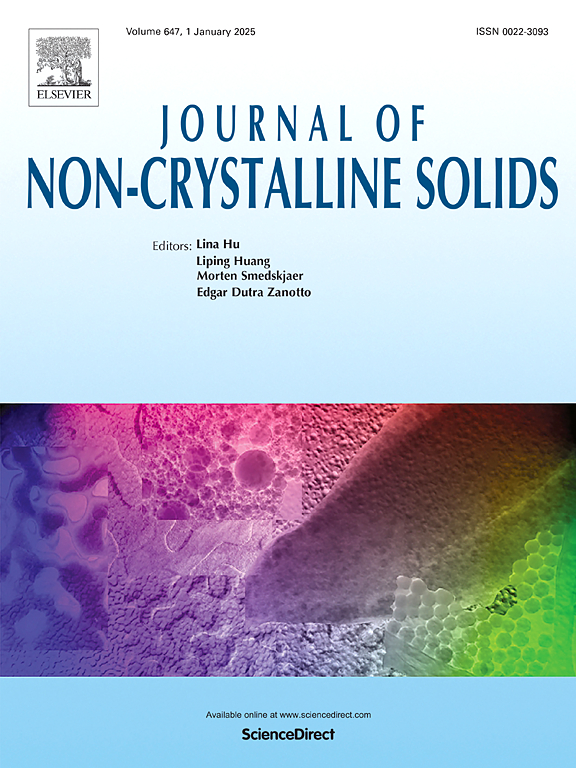高性能Al2O3-SiO2气凝胶/莫来石纤维复合材料具有优异的热稳定性和超低导热性,采用双硅源策略结合硅溶胶沉积改性
IF 3.2
3区 材料科学
Q1 MATERIALS SCIENCE, CERAMICS
引用次数: 0
摘要
在航空航天和高温工业设备对轻量化、高效保温材料的迫切需求驱动下,我们的研究进一步提高了传统铝硅基复合材料的耐温性能和保温性能。我们提出了一种创新的双硅源系统,利用正硅酸四乙酯(TEOS)和大颗粒硅溶胶(SS, d = 20 nm)。采用溶胶-凝胶法结合硅溶胶时效沉积,成功制备了高比表面积Al₂O₃- sio2气凝胶(SS-ASA)和莫来石纤维增强复合材料(SS-ASA/MF)。双硅源策略通过调节凝胶网络粗化抑制高温蠕变流动,而硅溶胶老化诱导Al-O-Si键重构,促进原位莫来石相成核。值得注意的是,即使在1200℃热处理后,SS-ASA也保持了143 m²/g的高比表面积。与莫来石纤维垫复合后,SS-ASA/MF表现出优异的综合性能:在1000℃封闭热源下加热20 min,冷侧温度保持在98.96℃,1000℃时导热系数低至0.071 W·m-¹·K-¹。值得注意的是,该复合材料在1200°C退火2小时后没有尺寸收缩,在1300°C热处理2小时后仅在厚度方向上收缩1.5%。该工作建立了优化Al₂O₃-SiO₂气凝胶和纤维增强复合材料的新方法,在航天器热防护系统和高温工业窑中具有重要的应用潜力。本文章由计算机程序翻译,如有差异,请以英文原文为准。
High-performance Al2O3-SiO2 aerogel/mullite fibre composites with exceptional thermal stability and ultralow thermal conductivity using dual-silicon-source strategy combined with silica sol deposition modification
Driven by the urgent demand for lightweight and high-efficiency thermal insulation materials in aerospace and high-temperature industrial equipment, our study has further improved the temperature resistance and insulation properties of traditional aluminium-silicon matrix composites. We proposed an innovative dual-silicon-source system utilizing tetraethyl orthosilicate (TEOS) and large-particle silica sol (SS, d = 20 nm). Through a sol-gel method integrated with silica sol aging deposition, high-specific-surface-area Al₂O₃-SiO₂ aerogels (SS-ASA) and the mullite fibre-reinforced composites (SS-ASA/MF) were successfully fabricated. The dual-silicon-source strategy suppressed high-temperature creep flow by modulating gel network coarsening, while silica sol aging induced Al-O-Si bond reconfiguration, promoting in situ mullite phase nucleation. Remarkably, SS-ASA retained a high specific surface area of 143 m²/g even after thermal treatment at 1200 °C. When composited with mullite fibre mats, SS-ASA/MF exhibited outstanding integrated performance: under a 1000 °C closed heat source for 20 min, the cold-side temperature remained at 98.96 °C, with a thermal conductivity as low as 0.071 W·m-¹·K-¹ at 1000 °C. Notably, the composite showed no dimensional shrinkage after annealing at 1200 °C for 2 h, and only 1.5 % in the thickness direction after heat treatment at 1300 °C for 2 h. This work establishes a novel approach for optimizing Al₂O₃-SiO₂ aerogels and fibre-reinforced composites, demonstrating significant application potential in spacecraft thermal protection systems and high-temperature industrial kilns.
求助全文
通过发布文献求助,成功后即可免费获取论文全文。
去求助
来源期刊

Journal of Non-crystalline Solids
工程技术-材料科学:硅酸盐
CiteScore
6.50
自引率
11.40%
发文量
576
审稿时长
35 days
期刊介绍:
The Journal of Non-Crystalline Solids publishes review articles, research papers, and Letters to the Editor on amorphous and glassy materials, including inorganic, organic, polymeric, hybrid and metallic systems. Papers on partially glassy materials, such as glass-ceramics and glass-matrix composites, and papers involving the liquid state are also included in so far as the properties of the liquid are relevant for the formation of the solid.
In all cases the papers must demonstrate both novelty and importance to the field, by way of significant advances in understanding or application of non-crystalline solids; in the case of Letters, a compelling case must also be made for expedited handling.
 求助内容:
求助内容: 应助结果提醒方式:
应助结果提醒方式:


